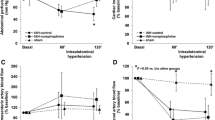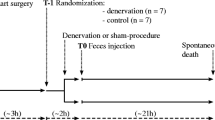Abstract
Objective
To study the effect of norepinephrine (NE) infusion on cerebral, coronary, renal and mesenteric blood flow during sepsis.
Design and setting
Randomised placebo-controlled animal trial in the animal laboratory of university physiology institute.
Animals
Seven merino cross-ewes.
Interventions
Chronic implantation of flow probes (aorta, renal, mesenteric and coronary artery and sagittal sinus). Induction of sepsis by intravenous bolus of E. coli (3×109). After the onset of hyperdynamic sepsis sheep were randomly allocated to either NE (0.4 µg kg−1 min−1) or placebo for 6 h.
Measurements and results
E. coli induced hypotension, fever, oliguria, tachycardia and tachypnoea. It increased cardiac output and renal, mesenteric and coronary blood flows. Sagittal flow remained unchanged. Compared to placebo NE infusion restored mean arterial blood pressure and further increased cardiac output. The increases in renal, mesenteric and coronary blood flow were unaffected. Sagittal flow was also unaltered. Compared to placebo NE increased myocardial performance, mean urine output and creatinine clearance at 2 h.
Conclusions
We conclude that hyperdynamic sepsis increases blood flow to heart, gut and kidney and that NE further increases cardiac output, blood pressure, myocardial performance, and urine output and creatinine clearance while maintaining regional blood flow.





Similar content being viewed by others
References
Schreuder WO, Schneider AJ, Groeneveld ABJ, Thijs LG (1989) Effect of dopamine vs. norepinephrine on hemodynamics in septic shock. Chest 95:1282–1288
Martin C, Papazian L, Perrin G, Saux P, Gouin F (1993) Norepinephrine or dopamine for the treatment of hyperdynamic septic shock? Chest 103:1826–1831
Desjars P, Pinaud M, Potel G, Tasseau F, Touze MD (1987) A reappraisal of norepinephrine therapy in human septic shock. Crit Care Med 15:134–137
Rudis MI, Basha MA, Zarowitz BJ (1996) Is it time to reposition vasopressors and inotropes in sepsis? Crit Care Med 24:525–537
Hesselvik JF, Brodin B (1989) Low dose norepinephrine in patients with septic shock and oliguria: effects on afterload, urine flow, and oxygen transport. Crit Care Med 17:179–180
Meier-Hellmann A, Reinhart K (1995) Effects of catecholamines on regional perfusion and oxygenation in critically ill patients. Acta Anaesthesiol Scand 39 [Suppl 107]:239–248
Task Force of the American College of Critical Care Medicine, Society of Critical Care Medicine (1999) Practice parameters for hemodynamic support of sepsis in adult patients in sepsis. Crit Care Med 27:639–660
Pawlik W, Sheperd AP, Jacobson ED (1975) Effect of vasoactive agents on intestinal oxygen consumption and blood flow in dogs. J Clin Invest 56:484–490
Sheperd AP, Pawlik W, Mailman D, Burks TF, Jacobson ED (1976) Effects of vasoconstrictors on intestinal vascular resistance and oxygen extraction. Am J Physiol 230:298–303
Gombos EA, Hulet WH, Bopp P (1962) Reactivity of renal and systemic circulations to vasoconstrictor agents in normotensive and hypertensive subjects. J Clin Invest 41:203–207
Mills LC, Moyer JH, Handley CA (1960) Effects of various sympathomimetic drugs on renal hemodynamics in normotensive and hypotensive dogs. Am J Physiol 198:1279–1285
Cronin RE, De Torrente A, Miller PD, Bulger RE, Burke TJ, Schrier RW (1978) Pathogenic mechanisms in early norepinephrine-induced acute renal failure: functional and histological correlates of protection. Kidney Int 14:115–125
Cronin R, Erickson AM, De Torrente A, McDonald KM, Schrier RW (1978) Norepinepherine-induced acute renal failure: a reversible ischemic model of acute renal failure. Kidney Int 14:187–190
Vincent J-L (2001) Hemodynamic support in septic shock Intensive Care Med 27:S80–S92
Abid O, Akca S, Michael PH, Vincent J-L (2000) Strong vasopressor support maybe futile in the intensive care unit patient with multiple organ failure. Crit Care Med 28:947–949
Grant DA, Franzini C, Wild J, Walker AM (1995) Continuous measurement of blood flow in the superior sagittal sinus of the lamb. Am J Physiol 269:R274–279
Bednarik JA, May CN (1995) Evaluation of a transit-time system for the chronic measurement of blood flow in conscious sheep. J Appl Physiol 78:524–530
Matthews JN, Altman DG, Campbell MJ, Royston P (1990) Analysis of serial measurements in medical research. BMJ 300:230–235
Nasraway SA (2000) Norepinephrine: no more "leave 'em dead"? Crit Care Med 28:3096–3097
Bellomo R, DiGiantomasso D (2001) Noradrenaline and the kidney: friends or foes. Crit Care 5:294–298
Bersten AD, Hersch M, Cheung H, Rutledge FS, Sibbald WJ (1992) The effect of various sympathomimetics on the regional circulation in hyperdynamic sepsis. Surgery 112:549–561
De Matteo R, May CN (1999) Inhibition of prostaglandin and nitric oxide synthesis prevents cortisol-induced renal vasodilatation in conscious sheep. Am J Physiol 276:R1125–R1131
Booke M, Hinder F, McGuire R, Traber LD, Traber DL (2000) Noradrenaline and N-monomethyl-L-arginine (L-NMMA): effects on haemodynamics and regional blood flow in healthy and septic sheep. Clin Science 98:193–2000
Booke M, Hinder F, McGuire R, Traber LD, Traber DL (1996) Nitric oxide inhibition versus norepinephrine for the treatment of hyperdynamic sepsis in sheep. Crit Care Med 24:835–844
Anderson WP, Korner PI, Selig SE (1981) Mechanisms involved in the renal responses to intravenous and renal artery infusions of noradrenaline in conscious dogs. J Physiol (Lond) 321:21–30
Bellomo R, Kellum JA, Wisniewski SR, Pinsky MR (1999) Effects of norepinephrine on the renal vasculature in normal and endotoxemic dogs. Am J Respir Crit Care Med 159:1186–1192
Schaer GL, Fink MP, Parrillo JE (1985) Norepinephrine alone versus norepinephrine plus low-dose dopamine: enhanced renal blood flow with combination pressor therapy. Crit Care Med 13:492–496
Zhang H, Smail N, Cabral A, Rogiers P, Vincent J-L (1997) Effects of norepinephrine on regional blood flow and oxygen extraction capabilities during endotoxic shock. Am J Respir Crit Care Med 155:1965–1971
Bersten AD, Hersch M, Cheung H, Rutledge FS, Sibbald WJ (1992) The effect of various sympathomimetics on the regional circulations in hyperdynamic sepsis. Surgery 112:549–561
Meier-Hellman A, Reinhart K (1995) Effects of catecholamines on regional perfusion and oxygenation in critically ill patients. Acta Anaesthesiol Scand 39 [Suppl 107]:239–248
Marik PE, Mohedin M (1994) The contrasting effects of dopamine and norepinephrine on systemic and splanchnic oxygen otilization in hyperdynamic sepsis. JAMA 272:1354–1357
Breslow MJ, Miller CF, Parker SD, Walman AT, Traystman RJ (1987) Effect of vasopressors on organ blood flow during endotoxin shock in pigs. Am J Physiol 252:H291–H300
Cunnion RE, Schaer GL, Parker M, Natanson C, Parrillo JE (1986) The coronary circulation in human septic shock. Circulation 73:637–644
Dhainaut J-F, Huyghebaert M-F, Monsallier JF, Lefevre G, Dall'Ava-Santucci J, Brunet F, Villemant D (1987) Coronary hemodynamics and myocardial metabolism of lactate, free fatty acids, glucose, and ketones in patients with septic shock. Circulation 75:533–541
Parker MM, Shelhamer JH, Bacharach SL, Green MV, Natanson C, Frederick TM, Danske BA, Parrillo JE (1984) Profound but reversible myocardial depression in patients with septic shock. Ann Intern Med 100:483–490
Leone M, Albanese J, Martin C (2002) Positive inotropic stimulation. Curr Opin Crit Care 8:395–403
Szabo L, Kovach AG, Babosa M, Greenberg JH, Revich M (1983) Effect of sustained norepinephrine infusion on local cerebral blood flow in the rat. Circ Shock 10:101–107
Myburgh JA, Upton RN, Grant C, Martinez A (1998) A comparison of the effects of norepinephrine, epinephrine, and dopamine on cerebral blood flow and oxygen utilization. Acta Neurochir (Wien) 71:19–21
Berntman L, Dahlgren N, Siesjo BK (1978) Influence of intravenously administered catecholamines on cerebral oxygen consumption and blood flow in the rat. Acta Physiol Scand 104:101–108
Redl-Wenzel EM, Armbruster C, Edelmann G, Fischl E, Kolacny M, Wechsler-Fordos A, Sporn P (1993) The effects of norepinephrine on hemodynamics and renal function in severe septic shock states. Intensive Care Med 19:151–154
Author information
Authors and Affiliations
Corresponding author
Additional information
This study was supported by an institute grant (no. 983001) from the National Health & Medical Research Council of Australia and by grants from the Intensive Care Foundation of the Australian and New Zealand Intensive Care Society, the Laerdal Foundation (Norway) and the ARMC Anaesthesia and Intensive Care Trust Fund.
An editorial regarding this article can be found in the same issue (http://dx.doi.org/10.1007/s00134-003-1794-z)
Rights and permissions
About this article
Cite this article
Di Giantomasso, D., May, C.N. & Bellomo, R. Norepinephrine and vital organ blood flow during experimental hyperdynamic sepsis. Intensive Care Med 29, 1774–1781 (2003). https://doi.org/10.1007/s00134-003-1736-9
Received:
Accepted:
Published:
Issue Date:
DOI: https://doi.org/10.1007/s00134-003-1736-9




